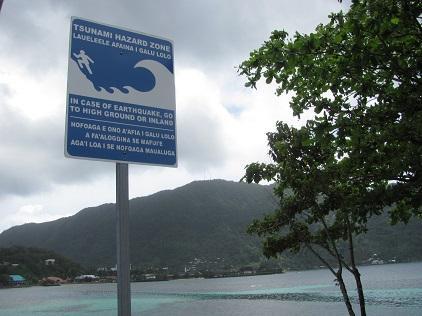
Tsunami warning signs, such as this one posted in American Samoa, are a key tool to raise public awareness of how to react (Photo: FEMA)
By Jonathan Fowler
PARIS, 27 June 2017 – Early warning technology is vital to save lives if a tsunami strikes, but public awareness of how to react is the critical factor, according to experts at an international meeting.
“Exposed communities need tsunami literacy,” Mr. Andi Eka Sakya of Indonesia’s BMKG Meteorological, Climatological and Geophysical Agency told the assembly of the UN Educational, Scientific and Cultural Organization’s Intergovernmental Oceanographic Commission (IOC-UNESCO).
The key is to hold regular national and international tsunami drills that bridge the “last mile” from experts to the general public and involve all members of communities, and to etch risk awareness into education and other policies, he underlined.
Mr. Sakya chairs of the multinational Indian Ocean Tsunami Warning and Mitigation System. It harnesses data from scores of seismographic and sea-level monitoring stations, with warnings spearheaded by Australia, India and Indonesia.
Mostly caused by earthquakes under the ocean floor, and to a lesser extent by volcanic eruptions or landslides, tsunamis are relatively rare. But they can be deadly: in the past 100 years, 58 have cost more than 260,000 lives. The average toll, 4,600 per disaster, surpasses any other natural hazard.
“Tsunamis are infrequent, but that does not disarm us,” said Ms. Christa von Hillebrandt-Andrade, Manager of the United States’ National Oceanic and Atmospheric Administration’s Caribbean Tsunami Warning Program.
Mr. Mike Angove, acting Director of the US National Tsunami Warning Center, recalled that in his days in the US Navy, officers likened tsunamis to a sea monster.
“They come out of nowhere, they strike suddenly, they cause immense damage, then they go away,” he said, noting that the risk of their slipping from public memory is a serious factor.
Mr. Angove, whose original field of expertise was tropical cyclones, underlined the gulf in warning times. For cyclones, countries and communities can have days to brace for the impact. In the case of a tsunami, they may only have minutes.
Despite huge strides in early warning technology – for example, real-time satellite monitoring – public understanding and action is the clinching factor.
“None of this makes a difference if you don’t have prepared communities. Preparedness and mitigation is half the battle. So we have to bring together the preparedness piece of the puzzle with the technology,” said Mr. Angove.
Sometimes it can take experience of a tsunami to spark real public understanding and action, said Ms. Filomena Nelson of the Samoan Disaster Management Office.
“Despite state of the art technology, lots of lives can be lost if people don’t understand the risk and what action to take,” said Ms. Nelson, noting that until the 2009 Samoa earthquake and tsunami, which claimed scores of lives, her efforts to raise awareness had gained little headway.